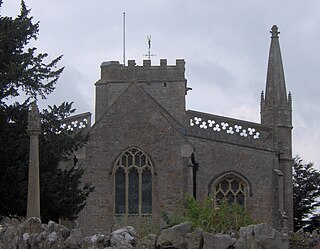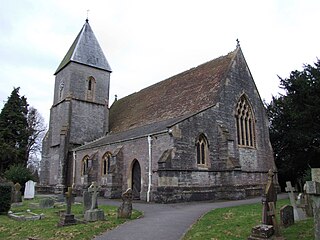
Street is a large village and civil parish in Somerset, England, with a population of 11,805 in 2011. On a dry spot in the Somerset Levels, at the end of the Polden Hills, it is two miles southwest of Glastonbury. There is evidence of Roman occupation. Much of the history of the village is dominated by Glastonbury Abbey, and a 12th-century causeway from Glastonbury built to transport local Blue Lias stone to it.

Whatley is a small rural village and civil parish about 2.5 miles (4 km) west of Frome in the English county of Somerset. The parish lies south of Mells and north of Nunney, and includes the hamlets of Lower Whatley and Chantry.

Walton is a village and civil parish on the Polden Hills in Somerset, England, 1.5 miles (2.4 km) west of Street. The parish includes the hamlet of Asney.

Holy Trinity Church is an Anglican Church in Nailsea, Somerset, England. It dates from the 15th century and is a Grade I listed building. It features a tower with 6 Bells, a cemetery, and a community centre called "The Trinity Centre".

Greinton is a village and civil parish in Somerset, England, situated on the Somerset Levels and Moors at the foot of the Polden Hills, 9 kilometres (5.6 mi) west southwest of Glastonbury and 7 miles (11 km) east of Bridgwater.

Crowcombe is a village and civil parish under the Quantock Hills in Somerset, England, 5.5 miles (9 km) southeast of Watchet, and 8 miles (13 km) from Taunton. The village has a population of 489.

The Grade I listed buildings in Somerset, England, demonstrate the history and diversity of its architecture. The ceremonial county of Somerset consists of a non-metropolitan county, administered by Somerset County Council, which is divided into five districts, and two unitary authorities. The districts of Somerset are West Somerset, South Somerset, Taunton Deane, Mendip and Sedgemoor. The two administratively independent unitary authorities, which were established on 1 April 1996 following the breakup of the county of Avon, are North Somerset and Bath and North East Somerset. These unitary authorities include areas that were once part of Somerset before the creation of Avon in 1974.

The Church of the Holy Trinity in Burrington, Somerset, England, is from the 15th century and was restored in 1884. It is a Grade I listed building.

The Church of the Holy Cross in Middlezoy, Somerset, England dates from the 13th century and has been designated as a grade I listed building.

The Church of St Peter in Huntspill, Somerset, England, was established by 1208, rebuilt around 1400, and extended in the early to mid-15th century. It was gutted by fire in 1878 and restored over the next two years. It has been designated a Grade I listed building.

The Church of St Christopher in Lympsham, Somerset, England dates from the 15th century, and has been designated as a Grade I listed building.

The Church of St Mary in Meare, Somerset, England, was formerly in the keeping of Glastonbury Abbey, and dates from 1323. It was built for Abbot Adam of Sodbury, and is a Grade I listed building.

The Church of St John the Baptist in Pilton, Somerset, England, dates from the 11th century and has been designated as a Grade I listed building.

The Church of St Nicholas in West Pennard, Somerset, England, dates from the 15th century and is a Grade I listed building.

The Church of St Peter at Podimore in the parish of Yeovilton, Somerset, England, dates from the early 14th century and has been designated as a Grade I listed building.

The Anglican Church of the Holy Trinity at Sutton Montis in the parish of South Cadbury and Sutton Montis, Somerset, England, has Saxon origins but most of the surviving building is from the 12th century and subsequent periods. It has been designated as a Grade I listed building.

The Church of St Julian in Wellow, Somerset, England has origins before the 12th century although the present building dates from 1372. It has been designated as a Grade I listed building.

The Anglican Church of the Holy Trinity at Chilton Trinity in the English county of Somerset was established in the 13th century. It is a Grade II* listed building.

Holy Trinity Church is a Church of England church in Walton, Somerset, England. It was rebuilt in 1865–66 to the design of Rev. J. F. Turner and is a Grade II listed building.

Holy Trinity Church is a former Church of England church in Godney, Somerset, England. Designed by George Phillips Manners, it was built in 1839–41 and made redundant in 1999. The church is now used for civil weddings and events as the Glastonbury Weddings and Events Venue. It is a Grade II listed building.





















